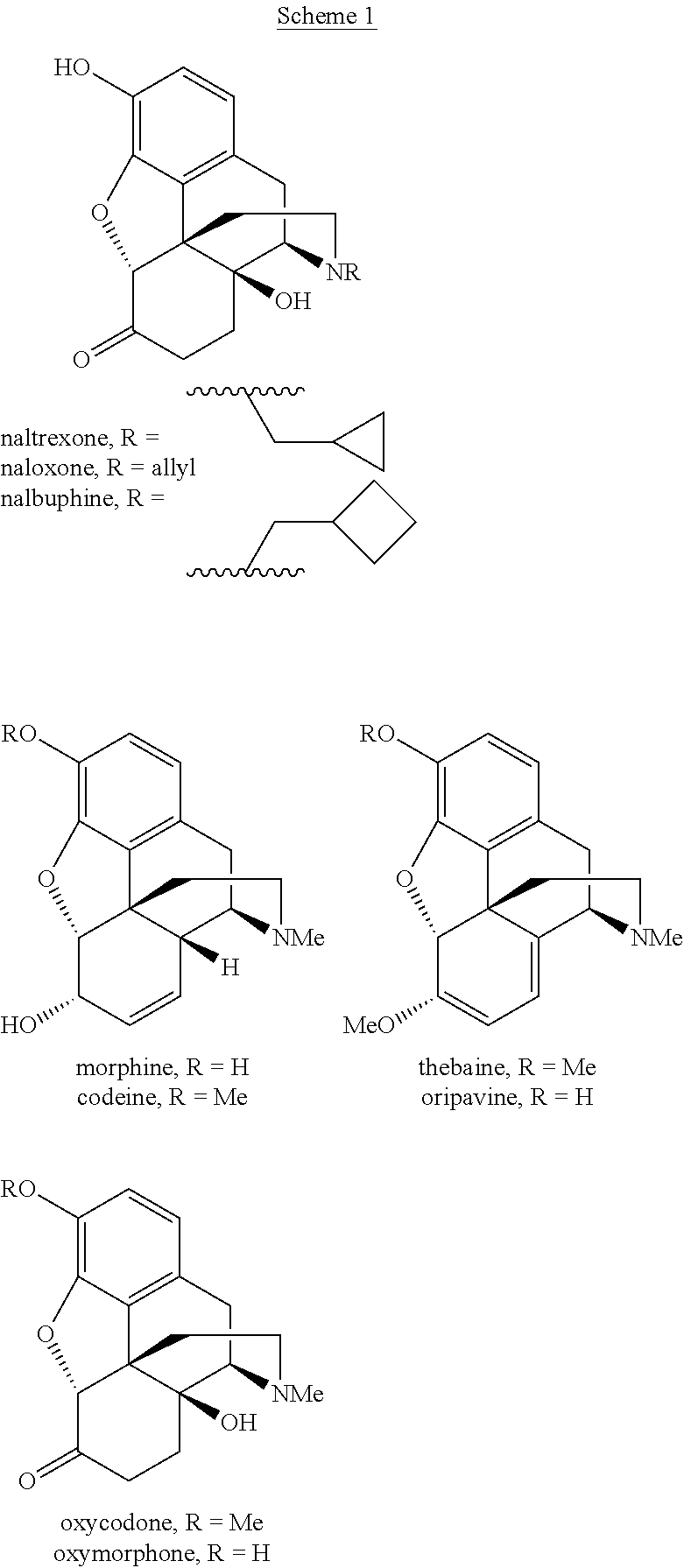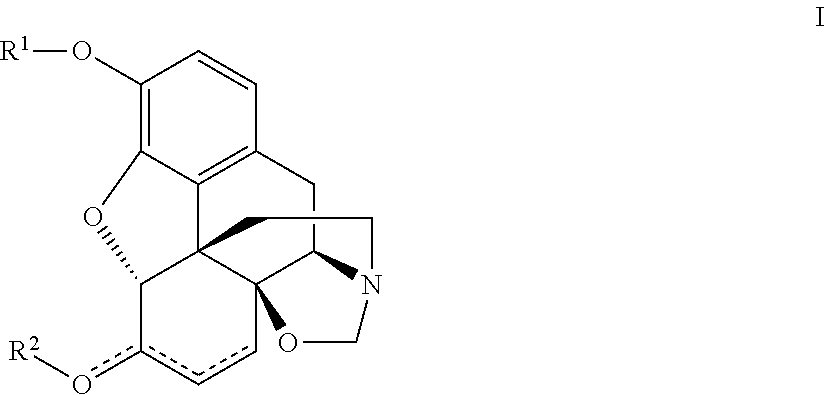Processes and Intermediates in the Preparation of Morphine Analogs via N-Demethylation of N-Oxides Using Cyclodehydration Reagents
a technology of cyclodehydration reagents and intermediates, which is applied in the field of intermediates in the preparation of morphine analogs via n-demethylation of noxides using cyclodehydration reagents, can solve the problems of not being very efficient or practical, and the challenge of n-demethylation of natural opiates
- Summary
- Abstract
- Description
- Claims
- Application Information
AI Technical Summary
Benefits of technology
Problems solved by technology
Method used
Image
Examples
example 1
General Procedure for N-Oxidations
[0104]To a solution of oxycodone, oxymorphone, or 3-O—Ac-oxymorphone (1 g scale) in dichloromethane (10 mL) cooled to 4° C. was added mCPBA (1 eq., 77% purity). The reaction mixture was stirred for 10 min and then added dropwise to vigorously stirred diethyl ether (100 mL). A white precipitate of product was filtered off to give nearly quantitative yield.
[0105]
[0106]RF=0.26 (dichloromethane / methanol / ammonium hydroxide 90:8:2); [α]D20=−167.6 (c 1, CHCl3); mp=220° C. (decomposition, Et2O); IR (KBr, cm−1) v 3426, 3018, 2997, 2956, 2932, 2862, 2832, 2312, 2243, 2160, 2133, 1900, 1723, 1632, 1606, 1533, 1499, 1461, 1436, 1342, 1312, 1256, 1160, 1017, 976, 933, 816; 1H NMR (CDCl3, 300 MHz) δ 6.76 (d, 1H, J=8.4 Hz), 6.67 (d, 1H, J=7.8 Hz), 4.78 (s, 1H), 3.92 (s, 3H), 3.62 (d, 1H, J=5.1 Hz), 3.34 (s, 3H), 3.31-3.10 (m, 6H), 2.24 (ddd, 1H, J=3.0, 3.0, 14.4 Hz), 1.97 (ddd, 1H, J=3.0, 4.8, 12.6 Hz), 1.70 (dd, 1H, J=3.3, 12.5 Hz), 1.61 (ddd...
example 2
(5aR,8aS,11aR,11bS)-2-methoxy-5,5a,9,10-tetrahydro-6,11b-ethano-7H-furo[2′,3′,4′,5′:4,5]phenanthro[9,8a-d]oxazol-11(11aH)-one
[0111]
[0112]Oxycodone N-oxide (Example 1a, 150 mg; 0.45 mmol) was dissolved in dichloromethane (10 mL). The reaction mixture was cooled to −20 to −25° C. in an acetone / N2(I) bath and Burgess reagent (150 mg; 0.63 mmol) was added as a solid in one portion. The reaction mixture was stirred for 5 hours and allowed to warm to room temperature. At −5° C. the color of the reaction mixture changed from colorless to yellowish. The mixture was then diluted with dichloromethane (50 mL) and washed with NaHCO3 (2×10 mL). The aqueous layer was re-extracted with dichloromethane (15 mL) and the combined organic layers were dried with MgSO4 and concentrated to yield 157 mg of the titled oxazolidine as a yellow solid. The compound was not stable on silica, low-melting, hygroscopic solid; data was collected at 90% purity.
[0113]RF=0.7 (dichloromethane / methanol / ammonium hydroxide...
example 3
(5aR,8aS,11aR,11bS)-2-Acetoxy-5,5a,9,10-tetrahydro-6,11b-ethano-7H-furo[2′,3′,4′,5′:4,5]phenanthro[9,8a-d]oxazol-11(11aH)-one, one-pot protocol
[0114]
[0115]Oxymorphone (600 mg; 1.99 mmol) was dissolved in tetrahydrofuran (8 mL). Solid K2CO3 (275 mg; 1.99 mmol) and acetic anhydride (188 μL, 1.99 mmol) were then added and the reaction mixture was stirred at room temperature for 1.5 hours. TLC (95 / 5 dichloromethane:methanol, double development) showed only traces of starting material. The reaction mixture was then cooled to ˜4° C. in an ice-bath, and a cold (4° C.) solution of mCPBA (446 mg; 1.99 mmol; 77% purity) in dichloromethane (6 mL) was added dropwise over a period of 1 minute. [The solution of mCPBA was prepared by dissolving 669 mg mCPBA (77%) in dichloromethane (9 mL) and adding MgSO4 (670 mg). The mixture was agitated several times over a period of 30 min and cooled in an ice-bath to 4° C.]. After 1 hour stirring, a white precipitate of N-oxide formed and the reaction mixture...
PUM
| Property | Measurement | Unit |
|---|---|---|
| reactivity | aaaaa | aaaaa |
Abstract
Description
Claims
Application Information
 Login to View More
Login to View More - R&D
- Intellectual Property
- Life Sciences
- Materials
- Tech Scout
- Unparalleled Data Quality
- Higher Quality Content
- 60% Fewer Hallucinations
Browse by: Latest US Patents, China's latest patents, Technical Efficacy Thesaurus, Application Domain, Technology Topic, Popular Technical Reports.
© 2025 PatSnap. All rights reserved.Legal|Privacy policy|Modern Slavery Act Transparency Statement|Sitemap|About US| Contact US: help@patsnap.com



